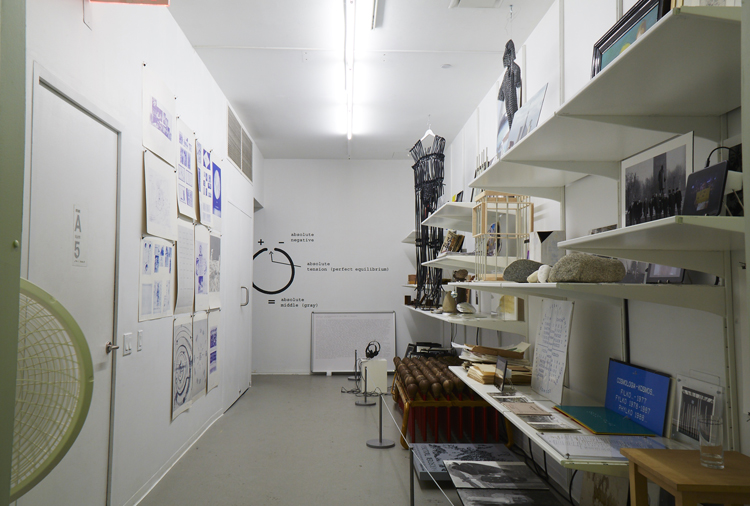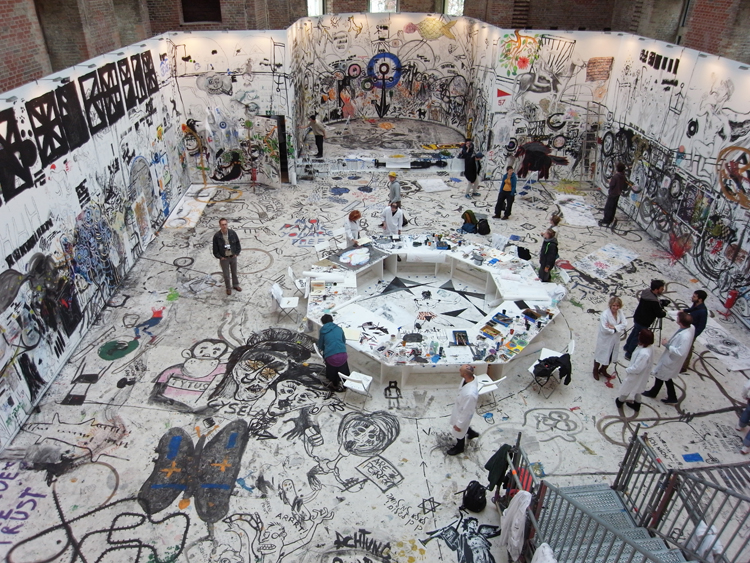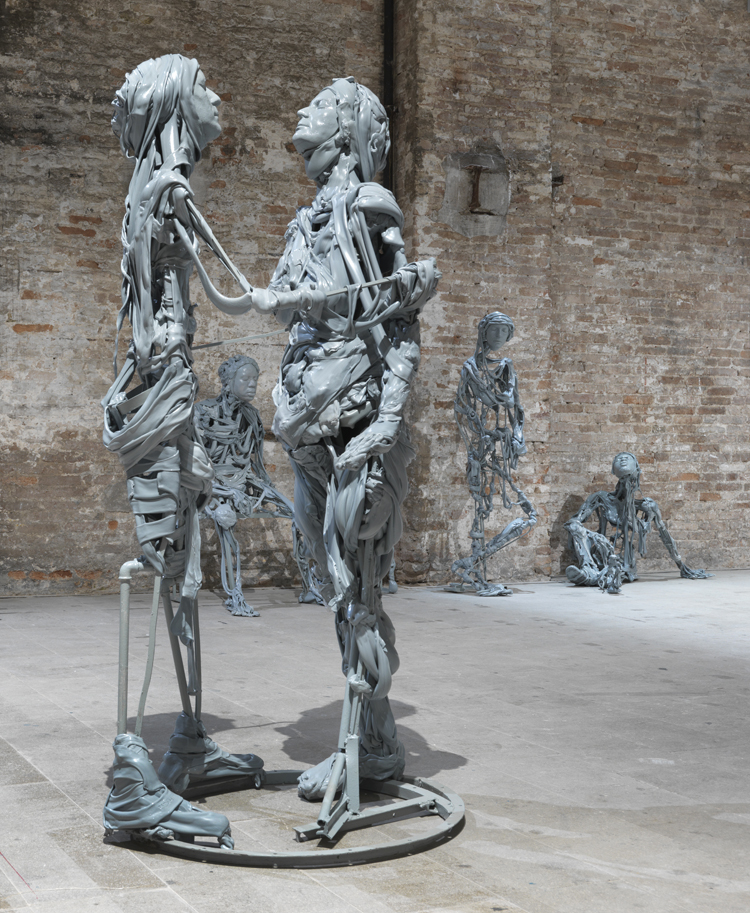Report on the Construction of a Spaceship Module and Paweł Althamer: The Neighbors at The New Museum, New York
Report on the Construction of a Spaceship Module, THE NEW MUSEUM, NEW YORK, JANUARY 22, 2014 – APRIL 13, 2014
PAWE? ALTHAMER: THE NEIGHBORS, THE NEW MUSEUM, NEW YORK, FEBRUARY 12, 2014 – APRIL 13, 2014

Two exhibitions of Central and Eastern European art were recently on view at the New Museum in New York. The first, Report on the Construction of a Spaceship Module, was part of the Museum as Hub series, a New Museum initiative supporting exhibitions, residencies, and public programsfocused on promoting international contemporary art. It was guest curated for the New Museum by a multinational team from tranzit.org, including Vít Havránek, Dóra Hegyi, and Georg Schöllhammer, the three directors of the tranzit organizations in Prague, Budapest, and Vienna, respectively.(There is no catalogue for this exhibition; however, a newspaper with new and reprinted texts as well as an extensive bibliography was published. A copy of it can be found here: http://235bowery.s3.amazonaws.com/exhibitionlinks/103/Tranzit_FINAL_small.pdf) The second, Pawe? Althamer: The Neighbors, was the largest survey of the Polish artist’s work to date and his first solo exhibition in the United States. Massimiliano Gioni, Associate Director and Director of Exhibitions, and Gary Carrion-Murayari, Curator, organized the exhibition, which was accompanied by a fully illustrated catalogue with new essays and an interview.(Massimiliano Gioni and Gary Carrion-Murayari, eds., Pawe? Althamer: The Neighbors (New York: Skira Rizzoli Publications, Inc., 2014).) Together, these exhibitions filled four out of the five floors in the museum, which in 2011 presented Ostalgia, a group exhibition of Soviet and post-Soviet art from the former Eastern Bloc that was as productive as it was problematic. These recent exhibitions attest to the New Museum’s continued interest in the region.
For Report on the Construction of a Spaceship Module, the fifth floor of the New Museum was divided into four rooms, which displayed a total of 117 artworks made since 1950 by established as well as emerging artists. The spaceship was designed to reflect the mixture of utopian and utilitarian aesthetics in Cold War era science fiction films, such as 1 April 2000 (1952), Ikarie XB1 (1963), and Solaris (1972). The museum’s mirrored, fluorescent-lit, neon-green elevators unintentionally enhanced the viewer’s experience of being beamed up to the spaceship, although the impact upon arrival was significantly less impressive. While the exhibition’s small rooms can become claustrophobic, its minimalist white interiors were not distinctive enough from the museum’s main galleries to be completely convincing. Report on the Construction of a Spaceship Module was set apart by what and how it presents to viewers.
The first room, the Archaeology of Futures Lab (AFL), introduced the viewer to tranzit, the network of independent organizations dedicated to research, publication, education, and creative projects reassessing the histories of Central and Eastern European art in both the local and global contexts. This room was lined with two large flat-screen televisions, two electronic tablets, and several headphones featuring a digitized selection of tranzit’s past and current projects. These included the recently launched website Parallel Chronologies: An Archive of East European Exhibitions, which collects and contextualizes documents and media that tell a history of unofficial art in the region not only through the artworks but also through the people and spaces that helped produce these important sites for expression and debate. While texts and images from the website flashed across a television on the left, the slideshow Soviet Modernism: Styles and Ideological Function, 1955-1991 was looped on the right. It featured over 700 period photographs of modernist architecture from across the former Soviet Union compiled by Schöllhammer and others at tranzit.at for the purposes of meditating on the pseudomorphic unity purported by communist utopian dreams. Lacking commentary, the images were difficult to locate in place and time. Their universalism complements the specificity of those in Parallel Chronologies, which narrates the details of individual events so that patterns and repetitions denoting intercultural connections can be seen more clearly. In the AFL, history and machine were fused, confronting the viewer with a fully digitized mediation of the past not unlike the means by which we procure and process information in our daily lives through computers, smart, phones, the Internet, and other automated systems.
 The adjoining Main Communication Room (MCR) was the exhibition’s primary space, which functioned regularly as a screening room for prerecorded presentations and live feeds, and occasionally as an auditorium for real-time and online lectures, discussions, and performances. A shallow banquette upholstered in plush white leather provided limited seating in front of a large screen on which one of twenty-five films could be viewed at any given time. Included within the over twenty-four hours of footage were an animation of actions and installations by Ji?í Kovanda, an illustrated account of Stano Filko’s work by Jan Verwoert, and a series of interviews by David Karas and Eszter Szakács with several curators associated with tranzit. Not only was the room too small to comfortably accommodate a crowd, but also the MCR presented the viewer with an information overload impossible to fully consume even in multiple visits. This was unfortunate because the materials shown help better understand and appreciate the parameters and impacts of Central and Eastern European art from the late twentieth and early twenty-first centuries, especially for those viewers less familiar with the social, political, and economic historical contexts of the region. Considering the challenges of spectatorship today when both images and viewers are constantly on the move, it is wishful thinking to suggest that one can fully digest such an excessive amount of information. As Boris Groys writes, “The whole point of visiting an exhibition of time-based art is to take a look at it and then another look and another look – but not to see it in its entirety,” as “the act of contemplation itself is put in a loop.”(Boris Groys, “Comrades of Time” e-flux journal 11 (December 2009) <http://www.e-flux.com/journal/comrades-of-time/>.)
The adjoining Main Communication Room (MCR) was the exhibition’s primary space, which functioned regularly as a screening room for prerecorded presentations and live feeds, and occasionally as an auditorium for real-time and online lectures, discussions, and performances. A shallow banquette upholstered in plush white leather provided limited seating in front of a large screen on which one of twenty-five films could be viewed at any given time. Included within the over twenty-four hours of footage were an animation of actions and installations by Ji?í Kovanda, an illustrated account of Stano Filko’s work by Jan Verwoert, and a series of interviews by David Karas and Eszter Szakács with several curators associated with tranzit. Not only was the room too small to comfortably accommodate a crowd, but also the MCR presented the viewer with an information overload impossible to fully consume even in multiple visits. This was unfortunate because the materials shown help better understand and appreciate the parameters and impacts of Central and Eastern European art from the late twentieth and early twenty-first centuries, especially for those viewers less familiar with the social, political, and economic historical contexts of the region. Considering the challenges of spectatorship today when both images and viewers are constantly on the move, it is wishful thinking to suggest that one can fully digest such an excessive amount of information. As Boris Groys writes, “The whole point of visiting an exhibition of time-based art is to take a look at it and then another look and another look – but not to see it in its entirety,” as “the act of contemplation itself is put in a loop.”(Boris Groys, “Comrades of Time” e-flux journal 11 (December 2009) <http://www.e-flux.com/journal/comrades-of-time/>.)
Three recent short films by Romanian and Hungarian artists Mihu? Bo?cu Kafchin, Zsuzsi Flohr, and the duo Igor and Ivan Buharov, which were shown in the corridor between the MCR and the Multi-Purpose Logistic Module (MPLM), elicited a similar response from the viewer. These films played consecutively on a small television screen positioned in a corner at floor level. This installation altered the perception of both the screen and the space, straining the phenomenological relationship between viewer and object. An ambiguous space, the corridor was a lost opportunity for a more constructive presentation of the works.
In contrast to the rapidly changing images encountered in the previous three rooms, the MPLM was the most sedate part of the spaceship. Here, one could survey eighty-two works of art from the last sixty years made, on the whole, by Central and Eastern European artists. There appeared to be no method to the madness of this collection, as its objects were fastened onto walls, scattered across the floor, and arranged on four tiers of shelves leaving the viewer a narrow path through this small rectangular room. The relationship between the works was not determined by style, medium, size, date, or country of origin—Tamás St. Turba was in front of Lia Perjovschi, Zsuzsi Ujj was next to Ion Grigorescu, Július Koller was nearby Andreas Fogarasi. This storehouse presented a nonlinear approach to art history through multiple and colliding temporalities that allowed the viewer to make free associations between and among disparate objects. Reproduction, manipulation, and appropriation are key strategies in many of the works, including the posthumous grid paintings by Piet Mondrian from the Museum of American Art in Berlin, Orshi Drozdik’s doctored series Individual Mythology (1975-1977) in which her naked body is superimposed onto historical photographs, and the digital images cut and pasted from Dan Perjovschi’s Facebook page showing the recent appropriation of his drawings by protestors.
These strategies at work in Report on the Construction of a Spaceship Module were also seen throughout Pawe? Althamer: The Neighbors, namely in the numerous sculptures recasting the artist’s self-portrait under various guises, a strategy for which Althamer is well known. Although a different kind of exhibition—a mid-career survey of a single artist—The Neighbors was equally preoccupied with the task of education. Recent writing on Althamer (b. 1967) characterizes his practice as a “pedagogic project” that visualizes the educational process through collaborative, performative, and time-lapse works that do not always yield conclusive results or final products.(Claire Bishop, “Pedagogic Projects,” in Artificial Hells: Participatory Art and the Politics of Spectatorship (London: Verso, 2012), pp. 255-260.) Althamer’s own art education is auspicious, having studied in the early 1990s at the Warsaw Academy of Fine Arts with Gregory Kowalski, the radical sculptor and performance artist who founded the Common Space-Private Space studio based on the theories of his teacher, postwar Polish modernist architect Oskar Hansen.
 With this legacy, Althamer inherits an artistic practice rooted in experimental actions aimed at stimulating interpersonal communication. He achieves this by setting up situations and environments, like the Draftsmen’s Congress, in which viewers are given the space, tools, and freedom to contribute directly toward a large collective work of art. First held during the Berlin Biennale 7 (2012) in a church repurposed as a community center, the Congress took over the entire fourth floor of the New Museum, where everyone—both paying museum visitors and invited community groups—became an artist. Purportedly interactive, most people, wearing smocks and wielding paintbrushes, were more interested in leaving their mark on the room’s floors and walls than in cooperating with others. However, a sense of equality permeated the chaotic overlaying of painted words and pictures, as even Althamer’s own contributions were painted over to make room for more.
With this legacy, Althamer inherits an artistic practice rooted in experimental actions aimed at stimulating interpersonal communication. He achieves this by setting up situations and environments, like the Draftsmen’s Congress, in which viewers are given the space, tools, and freedom to contribute directly toward a large collective work of art. First held during the Berlin Biennale 7 (2012) in a church repurposed as a community center, the Congress took over the entire fourth floor of the New Museum, where everyone—both paying museum visitors and invited community groups—became an artist. Purportedly interactive, most people, wearing smocks and wielding paintbrushes, were more interested in leaving their mark on the room’s floors and walls than in cooperating with others. However, a sense of equality permeated the chaotic overlaying of painted words and pictures, as even Althamer’s own contributions were painted over to make room for more.
Althamer’s sculptural production since his student days was summarized through twelve works on the New Museum’s third floor. Self-Portrait (1993) is a skillful, life-size, anatomically correct cast of the artist’s body executed in straw, hemp fiber, animal intestine, wax, and hair, and was part of his Master’s thesis. In its color, texture, and consistency, it recalls the work of Joseph Beuys, whose theories of material interaction and social sculpture heavily influence Althamer’s practice. The New Museum installation did not do justice to all of Althamer’s works. Made in collaboration with the Nowolipie Group, a Warsaw-based art class for multiple sclerosis sufferers that Althamer has taught since 1994, Slywia (2010) is a larger-than-life roughly shaped aluminum figure of a reclining nude with tussled hair and Cubo-Futurist limbs. It is a public work originally exhibited outdoors in New York’s City Hall Park. Inside the sterile galleries of the New Museum, the sculpture’s monumentalism was diminished, leaving it bereft of impact.
 The second and final floor of The Neighbors showcased Althamer’s most recent sculptural series Venetians (2013) alongside several films from 2003-2004 on which Althamer collaborated with longtime friend and colleague Artur ?mijewski. Althamer made Venetians for the 55th Venice Biennale, which Gioni curated, by casting the faces and hands of fifty people from diverse backgrounds, whom he befriended on the city’s streets. Althamer constructed the remainder of their bodies from metal wires and thick plastic ribbons draped like muscle fibers over their frames. The lithe, frail uniformity of their bodies is starkly contrasted with their solid, strong facial features. Whether a practical or pointed choice, the work’s wall label did not acknowledge each Venetian’s individuality, listing the series collectively even though each piece has a proper name. This group snapshot of Venice frozen in time would have been better paired with Common Task, Althamer’s ongoing and more well-known series of films in which he physically transports a group from his Warsaw neighborhood to other locations, including Brussels, Minsk, and the Mopti region of Mali. This popular and widely analyzed work is conspicuously missing from the exhibition. Instead, the curators chose to include eight more obscure films that chronicle Althamer’s research into and experimentation with mind-altering substances, such as LSD and peyote. These mental trips are more self-absorbed and far less accessible to the viewer, who needed to carefully read Althamer’s reactions to grasp the emotion magnitude of his journeys.
The second and final floor of The Neighbors showcased Althamer’s most recent sculptural series Venetians (2013) alongside several films from 2003-2004 on which Althamer collaborated with longtime friend and colleague Artur ?mijewski. Althamer made Venetians for the 55th Venice Biennale, which Gioni curated, by casting the faces and hands of fifty people from diverse backgrounds, whom he befriended on the city’s streets. Althamer constructed the remainder of their bodies from metal wires and thick plastic ribbons draped like muscle fibers over their frames. The lithe, frail uniformity of their bodies is starkly contrasted with their solid, strong facial features. Whether a practical or pointed choice, the work’s wall label did not acknowledge each Venetian’s individuality, listing the series collectively even though each piece has a proper name. This group snapshot of Venice frozen in time would have been better paired with Common Task, Althamer’s ongoing and more well-known series of films in which he physically transports a group from his Warsaw neighborhood to other locations, including Brussels, Minsk, and the Mopti region of Mali. This popular and widely analyzed work is conspicuously missing from the exhibition. Instead, the curators chose to include eight more obscure films that chronicle Althamer’s research into and experimentation with mind-altering substances, such as LSD and peyote. These mental trips are more self-absorbed and far less accessible to the viewer, who needed to carefully read Althamer’s reactions to grasp the emotion magnitude of his journeys.
Both exhibitions were milestones for the New Museum that fulfilled its original mission of presenting “new provocative art… in a critical and scholarly context… that is relevant to our lives… in ways that go beyond purely aesthetic concerns.”(Johanna Burton, the Keith Haring Director and Curator of Education and Public Engagement at the New Museum, showed and quoted these excerpts from early New Museum press releases at the symposium Is Contemporary Art History held on February 28, 2014 at New York University’s Institute of Fine Arts.) While the histories and artworks presented in tranzit’s multifaceted installation were considerably niche for the majority of New York’s art-going audience, there is hope that its archival platform can experience further growth on the global level.
More information on both exhibitions can be found on the websites for the New Museum (http://www.newmuseum.org) and tranzit (http://tranzit.org). Parallel Chronologies: An Archive of East European Exhibitions can be accessed at http://tranzit.org/exhibitionarchive/.



